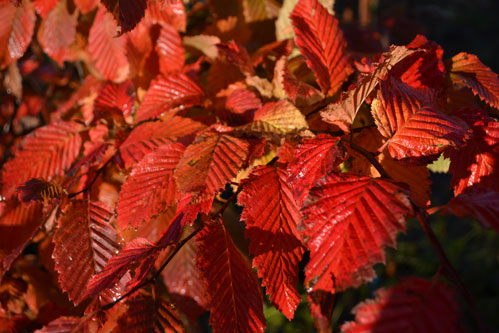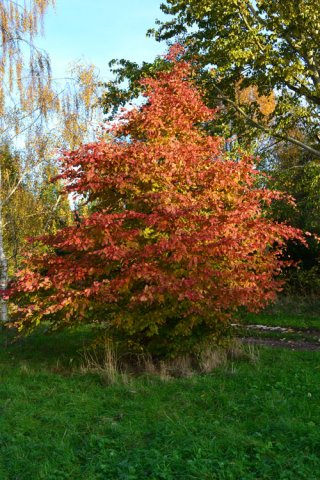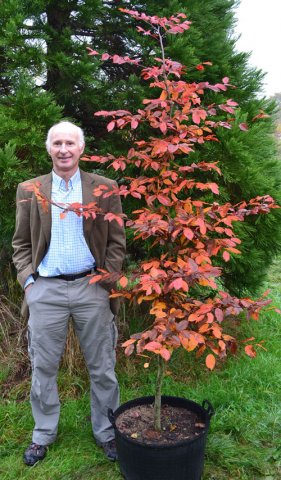
Carpinus betulus `Rockhampton Red`,(CBRR) Rockhampton Red Hornbeam
This cultivar of Carpinus betulus was discovered by Geoff Locke at the family Mount Pleasant Tree Nursery, Rockhampton, Gloucestershire, U.K. over 20 years ago. It was noticed among huge numbers of common hornbeam seedlings grown at the nursery. When about 10 years old the original tree was transplanted to the position in which it grows in our small arboretum.(more recently many other young specimens propagated from this tree have also been planted in the Mount Pleasant Arboretum.)

Carpinus betulus Rockhampton Red grows with the same growth rate and habit as normal Carpinus betulus, but in the Autumn, commencing in October, or sometimes late September the leaves start to turn different shades of bright red and orange these colours normally persist until mid-late November when the leaves turn brown. (All normal hornbeam tree leaves turn yellow or brown in the Autumn.) CBRR is beautiful when showing its red and orange autumn leaves and could be ranked alongside Liquidambar, Acers and Parrotia in terms of Autumn beauty.
A high proportion of the brown withered leaves remain on the tree until the following Spring.( as is the case with many specimens of common hornbeam, and normal beech hedging. .
The parent tree has consistently shown these characteristics over the last 20 years. Very occasionally one comes across specimens of common hornbeam which show a little orange autumn colouring some years, but in such examples this is normally not a consistent or reliable characteristic.
A propagation programme was started about 7 years ago by grafting from the parent tree onto rootstocks of common hornbeam.( Because the original parent tree has had so much propagating material taken from it ,it is rather stocky and bushy.)
So far several thousand trees of Carpinus betulus Rockhampton Red (CBRR) have been propagated in Nursery trials, the largest of the young trees exceed 4 metres in height. All the young plants reliably show the remarkably bright red Autumn colour commencing when they are 2 or 3 years old. The Autumn colour has been consistently red and orange where trial plantings have been made at 5 different locations on different soil types in the U.K. and also at a large site in Belgium at Pavia tree nursery,in Deerlijk and another in Southern France.

There is no previous record of a Carpinus betulus showing this intense and reliable Autumn colouration.
There are several other species of Carpinus in cultivation and a few of these show red Autumn leaves, but in the U.K. none of them are as fast and easy to grow as Carpinus betulus. The best known is Carpinus caroliniana a tree of American origin, it can produce good red Autumn colour, for a couple of weeks especially in the case of some clones, but is slow growing in the U.K. and only grows into a small or occasionally medium sized tree. It is also usually more difficult to grow. There are also one or two eastern Asian species which sometimes give good autumn colours but again these are smaller and much slower growing than common hornbeam.
There is an old cultivar of Carpinus betulus called `Purpurea` This tree sometimes has reddish purple leaves on young growth in the Spring but it is of very short duration and I have never seen a good or worthwhile specimen.
Common hornbeam and the variant Rockhampton Red is a very healthy growing species and grows very well in a very wide range of soil types including those which are poor and dry and/ or limey and will tolerate heavy waterlogged soils. It will grow healthily in bad soil conditions which few other trees would tolerate. It is tolerant of exposed and windy conditions and with its naturally strong root system it is very unlikely to be blown over or loosened in the soil, the branches are very strong and not liable to breakage. When the leaves fall in Winter and Spring they decompose quickly and do not present a slipping hazard. Common hornbeam is a very long lived species, and specimens of over 100 years of age are not uncommon.
Common hornbeam is one of the best deciduous trees for planting for screening and wind protection because of its reliability in all soil conditions and fine branch structure and the fact that it sometimes retains some withered leaves through the winter.
Carpinus betulus Rockhampton Red has all the above attributes, it can be planted in any situation where common hornbeam would normally be used.
Carpinus betulus `Rockhampton Red` (CBRR) grows quickly into a medium sized tree. A one year old grafted plant of 60 cm. can be expected to be 1.5 metres high after 1 growing season and 2.5 metres or more after 2 or 3 growing seasons. Five years after planting a 2 metre high young tree one can expect a tree 4- 5 metres high. Pruning cuts heal well and quickly so that the tree can be regularly pruned or trimmed.
Carpinus betulus Rockhampton Red`will provide even better screening than average common hornbeam because it normally retains a high proportion of withered leaves through the winter. Hornbeam has a fibrous root system and transplants very well, even as large trees up to 25 years old. Serious damage of hornbeam by pests and diseases is almost unknown, like almost all trees in the U.K. bark damage by grey squirrels can occur but such wounds normally heal quickly and do not generally seriously weaken branches.
CBRR is one of the very few medium sized trees with very good red Autumn colour which will grow healthily on alkaline (limey) soils.
Being a tree that is truly native to the U.K. and mainland Europe CBRR can be used in enviromentally sensitive schemes where only native trees are appropriate or allowable.
As well as having huge potential as amenity, garden, arboreta, specimen and street trees Carpinus betulus `Rockhampton Red` can be used very effectively for, screening trees, “hedges on stilts” or more formal pleached lines of trees, being of clonal origin the specimens will have very good uniformity which is very desirable in such applications. The cultivar will be ideal for avenues of trees because of its regularity of growth habit, excellent tolerance of pruning and reliability of growth. Mainland European nurseries have expressed particular interest in growing CBRR as a multi- stem tree.
A small scale launch of CBRR was made at the Four Oaks Horticultural Show near Manchester in September 2014 and there was great trade and public interest in the tree. It has been showcased at 2 mainland European shows in Autumn 2015 and won first prize for best new tree at Expo TCO a very important Dutch horticultural trade show.It was exhibited at Expo TCO by Batouwe Boomkwekerijen B.V. tree nursery of Dodewaard , Netherlands.
European Plant Breeders Rights has been granted in September 2018. Genesis Plant Marketing Ltd. made the application for this on our behalf and collect the royalties from the licenced propagators. The granting of plant breeders rights (no. EU50005)proves the uniqueness of this tree and gives us the original discoverers legal protection and unlicensed propagation is prohibited by law. In future years colour picture labels will be available. Application for American plant patent is pending.
This information note will be accessible via cbrr.co.uk and rockhamptonred.co.uk which will redirect to this mountpleasantfarmandforestry.co.uk website. For latest photos, news and prices of Carpinus betulus Rockhampton Red look at our sons website mountpleasanttrees.com
A limited number of trees of Carpinus betulus `Rockhampton Red` (CBRR) will be available this Winter from Mount Pleasant Farm and Forestry. www.mountp.co.uk.and Mount Pleasant Trees. www.mountpleasanttrees.com. In future years increasing numbers of CBRR will be more widely available from Mount Pleasant Trees, F.P. Matthews and other specialist U.K. tree nurseries. They will also be available from specially selected specialist mainland European tree nurseries, which have been chosen working in close collaboration with Mount Pleasant at Rockhampton and F.P. Matthews at Tenbury Wells. At present the mainland European nurseries with significant production are the specialist tree nursery Pavia in Deerlijk, Belgium and the wholesale tree nursery Batouwe in Dodewaard, Netherlands. Both are most highly respected nurseries.
Several other European nurseries, and one Canadian have expressed interest in either obtaining licences to propagate CBRR and some of these have been granted.
Some specimens of CBRR have been given to a selection of some of the famous U.K. arboreta and tree collections and also to the two National Collection holders of hornbeam species.
In mid October 2015 the tree won the Merite de Courson, highest award at the premier French Horticultural show. The autumn colours of tree judged there were not even fully developed at that time.
In 2018 after several years of testing for uniqueness and reliability of autumn red colouration full European Plant Breeders Rights were granted to me.
The tree remains the most popular specimen tree sold by Mount Pleasant Trees who are the largest supplier in the U.K.
I also grow a limited number of specimens of Carpinus betulus Rockhampton Red to large sizes which are also for sale from me.
G.G. Locke Aug.2020. cbrr3perch
.
.
.
.
.
.
.
.
.
.
.
.
.
.
